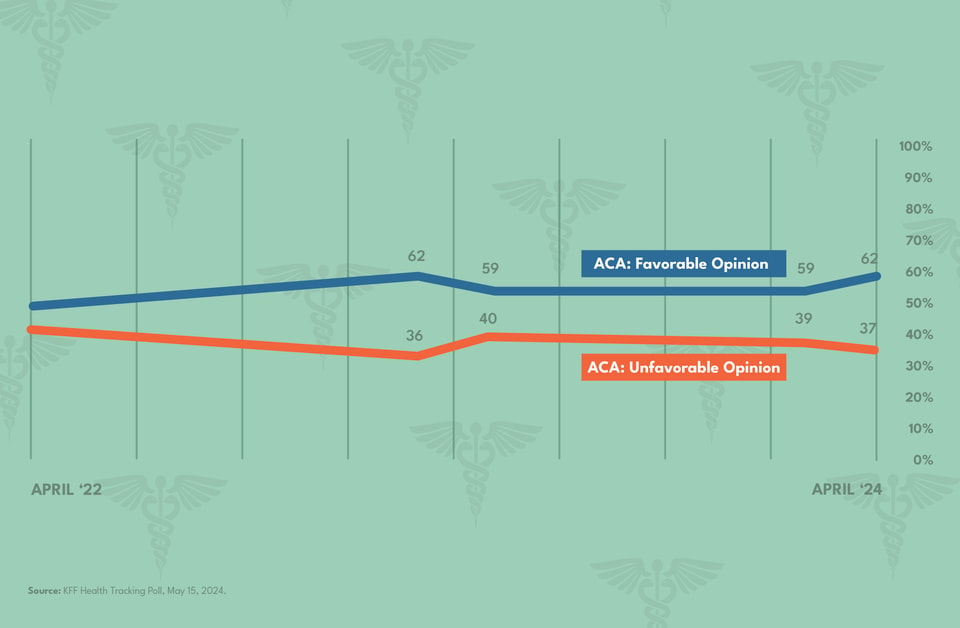Memo Published January 8, 2025 · 7 minute read
Health Care in 2025: What to Fight For & Fight Against
David Kendall, Darbin Wofford, & Kylie Murdock

For nine years, Donald Trump has vowed to “repeal and replace” the Affordable Care Act (ACA), what Republicans like to call Obamacare. And for nine years, we’ve waited to see the “replace” part of their equation. The repeal efforts have been real and threatening. An attempt to repeal the ACA narrowly escaped Trump’s axe in 2017 when Senator John McCain cast the deciding vote in favor of the law. Right-wing lawsuits argued before the Supreme Court also failed to bring down this historic Democratic accomplishment.
But in Trump 2.0, repeal and replace is back. Fox News has used the murder of United CEO Brian Thompson and the subsequent online reaction to his death as an evidence point on the failure of Obamacare. Republicans are now blaming the rise in health care costs on Obamacare in order to make efforts at repeal more popular with voters. At the same time, they still have no “replace” plan.
In this memo, we argue that our defense of the ACA should center on costs. Nearly everything the GOP will propose will shift costs to patients and American families. People could lose protections on pre-existing conditions, which will lead to higher costs. People could lose coverage, which will lead to higher costs. People could lose health care benefits, which will lead to higher costs. People could lose tax credits to help with their premiums, which will lead to higher costs.
Meanwhile, Republicans remain afraid of this issue because health care has worked so well for Democrats in prior elections. Nonetheless, they are still trying to chip away at federal health care benefits and will likely use the budget reconciliation process as the vehicle because it won’t need Democratic votes. Making constructive policy changes will, however, require bipartisan support.
Below are 10 policy areas where Democrats can play offense and defense on the ACA: five bipartisan ideas to improve the ACA and five ideas to defend the existing law. Each idea would lower costs for Americans (or at least protect them from higher costs).
Trump and Republicans have a repeal plan—let’s make it cost them.
Five Improvements to the ACA
- Lower hospital prices through bipartisan reforms. Hospital systems are buying up physician practices in order to consolidate market power and raise prices for patients. As a result, seniors are paying more than double for outpatient services like doctor’s visits, chemotherapy, and MRIs. Congress should build on recent efforts to address these issues. Last year, the House of Representatives passed the Lower Costs, More Transparency Act last year to lower seniors’ costs for drug administration services, and Senators Bill Cassidy (R-LA) and Maggie Hassan (D-NH) released a framework for legislation to ensure patients are paying the same price for the same service, regardless of where that service is performed.
- Lower medical debt by holding hospitals accountable for charity care. Nonprofit hospitals receive billions in federal tax breaks every year in exchange for providing “community benefits” such as free or discounted health care to low-income and uninsured people. But nonprofit hospitals provide less charity care than for-profit hospitals. Many also fail to offer financial assistance before turning patients over to bill collectors. These bad practices—along with others by nonprofit and for-profit hospitals—needlessly saddle millions of patients with medical debt. Democrats should build on bipartisan efforts to hold hospitals accountable for their charity care promises and reduce medical debt.
- Lower out-of-network fees by fixing surprise billing rules. The No Surprises Act made progress on ending surprise medical bills by shielding patients from unexpected charges from out-of-network providers. But much work remains. There are flaws in the law’s arbitration process that shift costs to patients’ insurance premiums. For example, when a provider wins in arbitration, patients’ health plans pay 322% of the median in-network rate—which increases premiums. Congress should end this cost-shifting by improving arbitration or simply limiting all surprise medical bills to the median in-network rate, as earlier versions of the No Surprises Act did. They should also extend protections against increased costs from ambulances.
- Lower drug costs for low-income patients by reforming 340B. The 340B Drug Pricing Program is an essential tool to help uninsured and low-income patients access lifesaving medicines. However, the program is not delivering lower costs to patients. Unlike federal grantees, such as community health centers and Ryan-White clinics, federal law does not require hospitals in 340B to lower costs for patients on discounted medications, despite receiving hefty discounts themselves. Congress should reform the 340B Program to ensure patients are adequately benefiting from the program by requiring 340B hospitals to reduce prices for discounted drugs and preventing these hospitals from engaging in aggressive medical debt collection.
- Stop drug shortages that block patient access to care and raise prices. Rising shortages for generic drugs are hurting patients with cancer and other diseases. Shortages also increase prices as hospitals, pharmacies, and other purchasers bid up the price of drugs in short supply. This volatile pricing stems from big drug purchasers driving prices so low that few generic drug manufacturers produce a given drug or have no reserve capacity when a natural disaster or other kinds of shocks hit a supply chain. Senate Finance Committee leaders Ron Wyden (D-OR) and Mike Crapo (R-ID) have proposed a way forward: pay purchasing organizations a little extra to ensure they purchase generic drugs with a reliable and resilient supply.
Five Defenses of the ACA
- Higher insurance costs by letting the ACA costs caps expire. Democrats capped health care premiums through the Affordable Care Act’s marketplaces. Initially, that made coverage affordable for low- to moderate-income workers and families who didn’t have coverage through an employer. Democrats then expanded those caps for everyone in 2021, reducing coverage costs by $705 a year on average. But those protections go away in 2025. If Republicans let the expanded caps expire, that would be the same as a tax increase for 20 million Americans.
- Higher health care costs and drug prices from reducing federal authority over prescription drugs. Congressional Republicans have vowed to end Medicare’s price negotiations and price limits, which have lowered drug prices. Secretary of Health and Human Service nominee Robert F. Kennedy, Jr. wants to slow drug approvals, which will limit the impact medicines have on reducing the cost of other expensive health care services. Kennedy’s attacks on vaccines and their manufacturers will lead to fewer vaccines and more deaths especially among children and higher health care costs from diseases.
- Higher costs for people with pre-existing conditions. The ACA stopped health plans from discriminating against people with pre-existing conditions using a wide range of measures—from insurance regulations to requirements for comprehensive benefits. Previous GOP efforts to repeal and replace the ACA would have undermined some, if not all, of those protections. Most recently, Vice President-elect J.D. Vance proposed a return to the days when people with pre-existing conditions had to get separate health coverage that was more expensive and often limited. Another threat is a policy from the first Trump Administration, ended by President Biden, which expanded short-term health care insurance. This allowed those health plans to discriminate against people with pre-existing conditions for unlimited periods of time.
- Higher medical debt from cutting coverage in Medicaid and ACA marketplaces. Republicans have threatened to cut Medicaid and repeal the ACA, potentially leaving millions of low- and middle-income families without access to health insurance. Without insurance, families risk being saddled with large medical bills and debt. Democrats should fight to protect Medicaid and the ACA to keep health care costs low. Ideas such as work requirements for low-income Americans in Medicaid would cause 600,000 Americans to lose coverage.
- Higher deductibles from expanding health savings accounts (HSAs). Republicans have promoted the use of high deductible coverage by giving tax breaks to health savings accounts linked to high deductible health plans. The theory is that health care spending would go down if people had to pay more of their health care costs directly, rather than through insurance. But high deductibles are not popular. Republicans want to get around that problem by increasing the annual limit on contributions to HSAs, which would shelter more income from taxes. That would help higher-income employees who could afford to make higher contributions, but it would also increase the use of high deductible plans for all employees. Democrats should instead fight to use limited federal dollars for affordable coverage for working and middle-class families.


